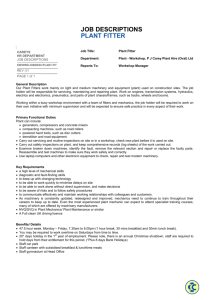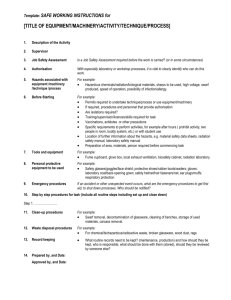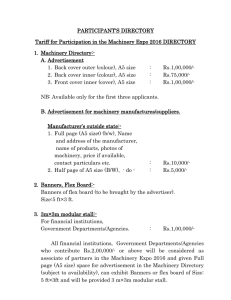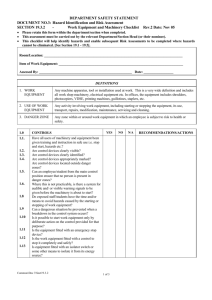(GUARDING AND OPERATION OF MACHINERY) REGULATIONS
advertisement
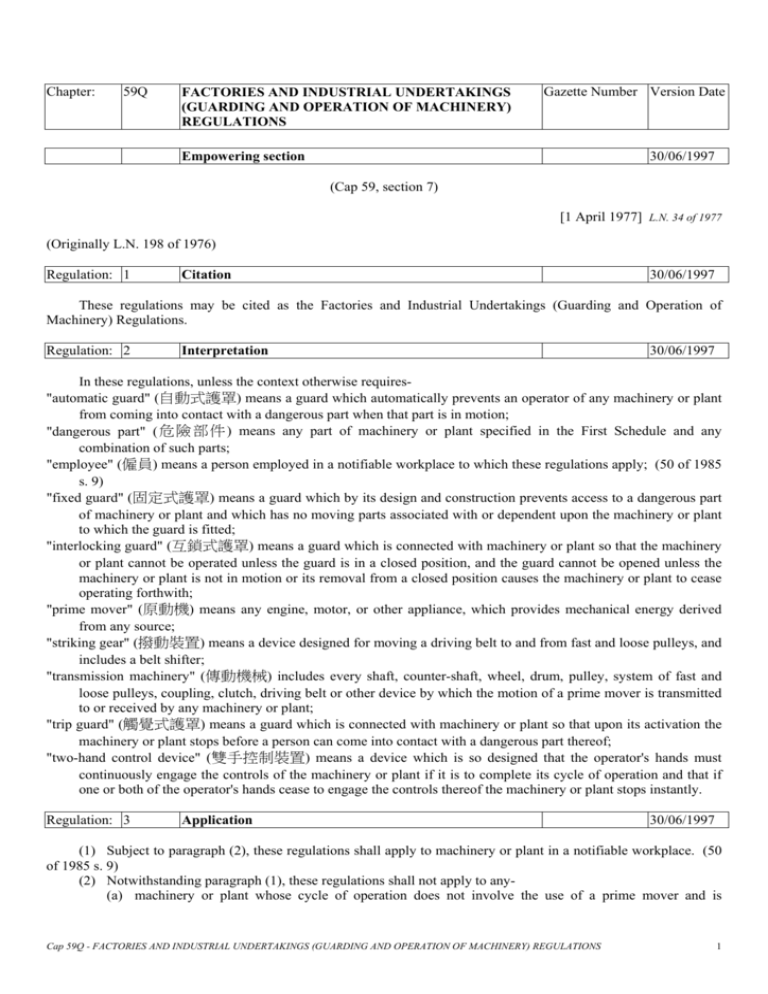
Chapter: 59Q FACTORIES AND INDUSTRIAL UNDERTAKINGS (GUARDING AND OPERATION OF MACHINERY) REGULATIONS Gazette Number Version Date 30/06/1997 Empowering section (Cap 59, section 7) [1 April 1977] L.N. 34 of 1977 (Originally L.N. 198 of 1976) Regulation: 1 Citation 30/06/1997 These regulations may be cited as the Factories and Industrial Undertakings (Guarding and Operation of Machinery) Regulations. Regulation: 2 Interpretation 30/06/1997 In these regulations, unless the context otherwise requires"automatic guard" (自動式護罩) means a guard which automatically prevents an operator of any machinery or plant from coming into contact with a dangerous part when that part is in motion; "dangerous part" ( 危險部件 ) means any part of machinery or plant specified in the First Schedule and any combination of such parts; "employee" (僱員) means a person employed in a notifiable workplace to which these regulations apply; (50 of 1985 s. 9) "fixed guard" (固定式護罩) means a guard which by its design and construction prevents access to a dangerous part of machinery or plant and which has no moving parts associated with or dependent upon the machinery or plant to which the guard is fitted; "interlocking guard" (互鎖式護罩) means a guard which is connected with machinery or plant so that the machinery or plant cannot be operated unless the guard is in a closed position, and the guard cannot be opened unless the machinery or plant is not in motion or its removal from a closed position causes the machinery or plant to cease operating forthwith; "prime mover" (原動機) means any engine, motor, or other appliance, which provides mechanical energy derived from any source; "striking gear" (撥動裝置) means a device designed for moving a driving belt to and from fast and loose pulleys, and includes a belt shifter; "transmission machinery" (傳動機械) includes every shaft, counter-shaft, wheel, drum, pulley, system of fast and loose pulleys, coupling, clutch, driving belt or other device by which the motion of a prime mover is transmitted to or received by any machinery or plant; "trip guard" (觸覺式護罩) means a guard which is connected with machinery or plant so that upon its activation the machinery or plant stops before a person can come into contact with a dangerous part thereof; "two-hand control device" (雙手控制裝置) means a device which is so designed that the operator's hands must continuously engage the controls of the machinery or plant if it is to complete its cycle of operation and that if one or both of the operator's hands cease to engage the controls thereof the machinery or plant stops instantly. Regulation: 3 Application 30/06/1997 (1) Subject to paragraph (2), these regulations shall apply to machinery or plant in a notifiable workplace. (50 of 1985 s. 9) (2) Notwithstanding paragraph (1), these regulations shall not apply to any(a) machinery or plant whose cycle of operation does not involve the use of a prime mover and is Cap 59Q - FACTORIES AND INDUSTRIAL UNDERTAKINGS (GUARDING AND OPERATION OF MACHINERY) REGULATIONS 1 dependent solely upon manual labour; (b) machinery or plant that is portable and is designed for carrying about by manual labour and for operation while held by hand; and (c) machinery or plant of the parts and description set out in column A of the Second Schedule and to which the regulations opposite thereto in column B apply. Regulation: 4 Guarding of dangerous parts 30/06/1997 (1) Subject to paragraph (2), a dangerous part shall be effectively guarded in accordance with and in the manner provided by regulation 5. (2) Notwithstanding paragraph (1), a dangerous part which by reason of(a) its position; (b) its construction; or (c) the nature of the work being performed, does not give rise to any reasonably foreseeable hazard to the safety of any person present at a notifiable workplace need not be guarded as provided in regulation 5. (50 of 1985 s. 9) Regulation: 5 Method of guarding 30/06/1997 (1) Subject to paragraph (3), effective guarding of a dangerous part shall be achieved either by any one of the following methods or by a combination of any of them(a) by a fixed guard; (b) by an interlocking guard; (c) by an automatic guard; (d) by a trip guard; (e) by a two-hand control device. (2) Subject to paragraph (3), every guard or device used pursuant to paragraph (1) shall be(a) of substantial construction; (b) maintained in an efficient condition; and (c) kept in its proper position while the machinery or plant is in motion. (3) Notwithstanding paragraphs (1) and (2), a guard or device may be removed or rendered inoperative while the machinery or plant is in motion and a dangerous part is necessarily exposed for he purpose of any examination, being an examination which can only be made with the machinery or plant in motion, or of any lubrication or adjustment shown by an examination to be immediately necessary, being a lubrication or adjustment which can only be done with the machinery or plant in motion. (4) A guard or device removed or rendered inoperative pursuant to paragraph (3) shall be immediately replaced or rendered operative upon completion of the purpose for which it was so removed or rendered inoperative. Regulation: 6 Fixed guards may have openings 30/06/1997 (1) Subject to paragraph (2) an opening may be provided in any fixed guard for the insertion and withdrawal of material from machinery or plant. (2) An opening in a fixed guard shall(a) in the case of a fixed guard used in connexion with an automatic feeding device or any gravity feeding system, be as small as is practicable having regard to the operation of the machinery or plant; (b) in every other case, conform to the Table set out in the Third Schedule so that the distance of the fixed guard from any dangerous part shall be not less in any case than the distance set out in column B opposite to the size of opening set out in column A. Regulation: 7 Young persons working at machines 30/06/1997 A young person shall not work at or operate any machine specified in the Fourth Schedule unless he has been fully instructed as to the dangers arising in the use of the machine and the precautions to be observed, and he has either been given training to the extent that he is proficient in work at and the operation of the machine or he is under Cap 59Q - FACTORIES AND INDUSTRIAL UNDERTAKINGS (GUARDING AND OPERATION OF MACHINERY) REGULATIONS 2 supervision by a person who has a knowledge of and is experienced in work at and the operation of the machine. Regulation: 8 Starting and stopping devices 30/06/1997 Machinery or plant shall be equipped with an efficient starting and stopping device and the controls of the device shall be designed and constructed with proper regard to the safe working of the machinery or plant and so placed as to be readily and conveniently operated. Regulation: 9 Push button controls to have emergency stopping devices 30/06/1997 Machinery or plant driven by 2 or more motors with separate push button controls shall be equipped with one or more overriding stopping devices by means of which the machinery or plant can be stopped forthwith and, where there is more than one stopping device, such devices shall be so spaced as to enable their effective and convenient operation. Regulation: 10 Stock-bars 30/06/1997 Any part of a stock-bar which projects beyond the headstock of a lathe shall be effectively guarded in the manner prescribed by regulation 5 unless it is in such a position as to be as safe to every person present at the notifiable workplace as it would be if effectively guarded. (50 of 1985 s. 9) Regulation: 11 Belts and pulleys 30/06/1997 (1) Machinery or plant not directly driven by an individual motor or other prime mover but driven through a system of belt, pulley and shaft or counter-shaft shall be equipped with(a) a clutch; (b) a loose pulley; or (c) other adequate means readily accessible to an operator for the effective starting and stopping of the machinery or plant. (2) No driving belt shall rest or ride upon a revolving shaft forming part of any transmission machinery. (3) For the purposes of moving a driving belt to and from fast and loose pulleys forming part of any transmission machinery, suitable striking gear shall be provided and shall be constructed, placed and maintained so as to prevent the driving belt from creeping back or shifting on to a fast pulley while the driving belt is in motion on a loose pulley. (4) Where a foot pedal forms part of any transmission machinery for the purpose of operating a clutch, it shall be effectively guarded against being unintentionally or accidentally struck so as to operate the clutch. Regulation: 12 Responsibilities of proprietors, employees and other persons 30/06/1997 (1) No proprietor, employee or other person shall wilfully and without reasonable cause, remove, render inoperative, misuse, damage or interfere with any guard or device provided in pursuance of these regulations. (2) Every employee shall make full and proper use of any guard or device provided in pursuance of these regulations. (3) Every employee shall report forthwith to the proprietor any fault or defect in any guard or device provided in pursuance of these regulations. Regulation: 13 Offences 30/06/1997 (1) The proprietor of any notifiable workplace in respect of which any of the provisions of regulation 4, 6(2), 7, 8, 9, 10, 11 or 12(1) are contravened shall be guilty of an offence and shall- (50 of 1985 s. 9) (a) in respect of a contravention of regulation 4, 7, 10 or 12 (1), be liable to a fine of $50000; (b) in respect of a contravention of regulation 6(2), 8, 9 or 11, be liable to a fine of $50000. (L.N. 37 of Cap 59Q - FACTORIES AND INDUSTRIAL UNDERTAKINGS (GUARDING AND OPERATION OF MACHINERY) REGULATIONS 3 1994) (2) An employee or a person other than a proprietor who contravenes regulation 12(1) shall be guilty of an offence and shall be liable on conviction to a fine of $50000. (L.N. 37 of 1994) (3) An employee who contravenes any of the provisions of regulation 12(2) or 12(3) shall be guilty of an offence and shall be liable on conviction to a fine of $10000. (L.N. 117 of 1981) Schedule: 1 DANGEROUS PARTS OF MACHINERY OR PLANT 32 of 2000 09/06/2000 [regulation 2] 1. 2. 3. 4. 5. 6. 7. 8. 9. 10. 11. 12. 13. 14. 15. 16. 17. Revolving shafts, couplings, spindles, mandrels, bars and flywheels. In-running nips between pairs of rotating parts. In-running nips of the belt and pulley type. Projections on revolving parts. Discontinuous rotating parts. Revolving beaters, spiked cylinders and revolving drums. Revolving mixer arms in casings fitted with openings. Revolving worms and spirals in casings fitted with openings. Revolving high-speed cages in casings fitted with openings. Revolving cutting tools. Reciprocating cutting tools. Reciprocating press tools and dies. Reciprocating needles. Closing nips between platen motions. Projecting belt fasteners and fast running belts. Nips between connecting rods or links, and rotating wheel cranks or discs. (32 of 2000 s. 48) Traps arising from the traversing carriages of self-acting machines. Schedule: 2 30/06/1997 PARTS OF MACHINERY OR PLANT TO WHICH THESE REGULATIONS DO NOT APPLY [regulation 3(2)(c)] A Parts and Description Circular saw, the blade Swing saw, the blade Pendulum saw, the blade Plain band saw, the blade Planing machine, the cutter Vertical spindle moulding machine, the cutter Chain mortising machine, the chain Every flywheel and moving part of any prime mover Every part of transmission machinery Every dangerous part of other machinery (whether or not driven by a prime mover) B Applicable Regulations Factories and Industrial Undertakings (Woodworking Machinery) Regulations (Cap 59 sub. leg. G) reg. 10 reg. 12 reg. 12 reg. 13 reg. 14 reg. 15 reg. 16 Construction Sites (Safety) Regulations (Cap 59 sub. leg. I) reg. 44 reg. 44 reg. 44 Cap 59Q - FACTORIES AND INDUSTRIAL UNDERTAKINGS (GUARDING AND OPERATION OF MACHINERY) REGULATIONS 4 Factories and Industrial Undertakings (Abrasive Wheels) Regulations (Cap 59 sub. leg. L) regs. 8 and 9 Abrasive wheel Schedule: 3 30/06/1997 OPENINGS IN FIXED GUARDS [regulation 6(2)] A B Size of opening in millimetres measured at the widest point Distance of guard from any dangerous part in millimetres More than 6 10 12 15 20 22 30 40 50 55 150 Schedule: 4 But not more than 6 10 12 15 20 22 30 40 50 55 150 Not less than 40 40 65 90 140 165 190 320 400 450 800 800 MACHINES NOT TO BE WORKED AT BY YOUNG PERSONS UNLESS TRAINED OR SUPERVISED 30/06/1997 [regulation 7] 1. 2. 3. 4. 5. 6. 7. 8. 9. 10. 11. 12. 13. Power presses, including hydraulic and pneumatic presses. Loose knife punching machines. Milling machines, other than those used in tool-room operation. Dough brakes. Dough mixers. Hydro-extractors. Calenders. (L.N. 377 of 1981) Washing machines. Garment presses. Paper baling presses. Guillotines. Hand fed platen printing machines. Hand fed embossing machines. Cap 59Q - FACTORIES AND INDUSTRIAL UNDERTAKINGS (GUARDING AND OPERATION OF MACHINERY) REGULATIONS 5
